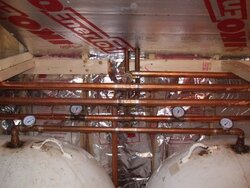Does stratification in a closed storage container really have much benefit?
In an open system, using coils within a stationary body of storage water, I can see where the benefit would be great. When charging the storage, the cooler water at the bottom will remove more heat from the boiler water in the coil. When removing heat from storage, the hotter water at the top will increase the water temperature going into the house. In this design, using a coil in the storage allows the storage water to be undisturbed and convection will ensure that the hotter water ends up at the top.
Using two propane tanks in a closed system, the benefits are not so clear. A 125k boiler needs about 14 gpm to remove the heat from the boiler. This continuous flow through the tanks will prevent stratification. Any zone calling for heat will probably cause a 5gpm flow.
The tank that the boiler water enters first will end up being the hotter of the two. This will be ok as long as the flow is reversed to heat the house using this hotter water first.
If frequent water movement through the tanks prevents convection, and therefore stratification, what difference does it make if the tanks are mounted vertical, one above the other, or side by side?
What is the opinion of the people who know more about this stuff than I?
Jim
In an open system, using coils within a stationary body of storage water, I can see where the benefit would be great. When charging the storage, the cooler water at the bottom will remove more heat from the boiler water in the coil. When removing heat from storage, the hotter water at the top will increase the water temperature going into the house. In this design, using a coil in the storage allows the storage water to be undisturbed and convection will ensure that the hotter water ends up at the top.
Using two propane tanks in a closed system, the benefits are not so clear. A 125k boiler needs about 14 gpm to remove the heat from the boiler. This continuous flow through the tanks will prevent stratification. Any zone calling for heat will probably cause a 5gpm flow.
The tank that the boiler water enters first will end up being the hotter of the two. This will be ok as long as the flow is reversed to heat the house using this hotter water first.
If frequent water movement through the tanks prevents convection, and therefore stratification, what difference does it make if the tanks are mounted vertical, one above the other, or side by side?
What is the opinion of the people who know more about this stuff than I?
Jim


